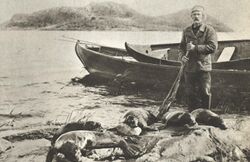Biology:Ladoga ringed seal
| Ladoga ringed seal | |
|---|---|
| Scientific classification | |
| Domain: | Eukaryota |
| Kingdom: | Animalia |
| Phylum: | Chordata |
| Class: | Mammalia |
| Order: | Carnivora |
| Clade: | Pinnipedia |
| Family: | Phocidae |
| Genus: | Pusa |
| Species: | |
| Subspecies: | P. h. ladogensis
|
| Trinomial name | |
| Pusa hispida ladogensis (Nordquist, 1899)
| |
| Synonyms | |
|
Phoca hispida ladogensis
| |
The Ladoga ringed seal (Russian: Ладожская нерпа; Pusa hispida ladogensis) is a freshwater subspecies of the ringed seal (Pusa hispida) found entirely in Lake Ladoga in northwestern Russia . The Ladoga ringed seal was isolated in freshwater lakes and separated from the Arctic ringed seal as a result of the isostatic rebound of the region following the end of the Weichselian Glaciation.[1]
It is related to the even smaller population of Saimaa ringed seals in Lake Saimaa, a lake that flows into Ladoga through the Vuoksi River.
Appearance
The adult Ladoga seal grows to about 150 cm in length and weighs approximately 60–70 kg. Pups are approximately 50–60 cm at birth and weigh approximately 4–5 kg. There are four variations of coats.[2] About 47% of Ladoga seals have a dark brown coat with lighter ring shaped patterns, 29% have a dark brown coat with lighter vein-like patterns, and 17% have a light brown coat with a dark dorsal belt as well as faint rings and spots. The coats of the remaining 7% are not described by Popov. Annual molting takes place from April through June.
Reproduction
Females reach maturity at the age of four to five, and males at the age of six to seven. Pups are delivered in February through March, with weaning taking place after six to eight weeks. A normal lifespan is about 30–35 years.[3]
Conservation
The current population is about 2,000–3,000, down from approximately 20,000 at the beginning of the 20th century, due to overhunting; hunting of the seals was banned entirely in 1980, but some illegal poaching still occurs.[4][5] The species' primary threats include entanglement in fisheries netting, industrialization in the areas surrounding Lake Ladoga, fuel spills from water vessels and the disturbance of their warm-weather sunning places by human recreational activities. The Ladoga seal is listed as an Appendix II species under the Bern Convention and also included in the Red Data Book of the Russian Federation.
See also
- Pinniped
- Saimaa ringed seal
Notes
- ↑ Davydova, Natalia N.; et al. (1996). "Late- and postglacial history of lakes of the Karelian Isthmus". Hydrobiologia. 322(1–3): 199–204. doi:10.1007/BF00031828. S2CID 9631019.
- ↑ Popov, L. "Ladoga Seal." Mammals in the Seas, volume II: pinniped species summaries and report on sirenians (FAO Fisheries Series) No. 5, Vol II, pp. 70–71
- ↑ Frost, K.J., Lowry, L.F. 1981. "Ringed, Baikal and Caspian seals, Phoca hispida Schreber, 1775, Phoca sibirica Gmelin, 1788, Phoca caspica Gmelin, 1788." Ridgway, S.H. and Harrison, R.J. (eds.): Handbook of Marine Mammals (Academic Press Inc., London) Vol. 2: Seals, pp. 29–53
- ↑ Chapskiy K.K. (1932) Ladozhskiy tyulen i vozmozhnost ego promyisla. – Otchet dlya Leningradskogo Issledovatelskogo instituta ryibolovstva: 147 – 157.
- ↑ Verevkin M.V. (2003) Rezultatyi aviaucheta kolchatoy nerpyi na Ladozhskom ozere Dinamika populyatsiy ohotnichih zhivotnyih severnoy Evropyi, materialyi III Mezhdunarodnogo simpoziuma, 16-20 July 2002, Sortavala, Republic of Karelia, Russia. - Petrozavodsk. – 2003: 202-204.
References
- IUCN Red List of Threatened Species
- Ladoga Seal
- Small comparison with Saimaa seal
- Seal Conservation Society
- Ladoga Seal in Brief
- Yablokov, A. (1985) Marine mammal-fishery interactions in the Baikal and Ladoga Lakes and in the Caspian and White Seas. in: Beddington, J.R., Beverton, R.J.H. and Lavigne, D.M. (eds.): Marine Mammals and Fisheries, pp. 106–110, George Allen & Unwin (Publishers) Ltd, London
Wikidata ☰ Q2558790 entry
 |



